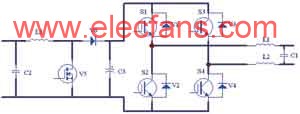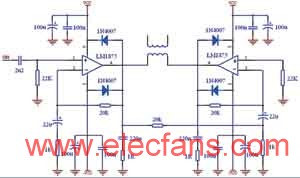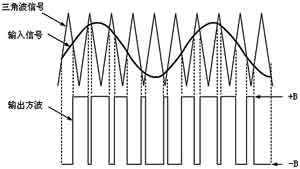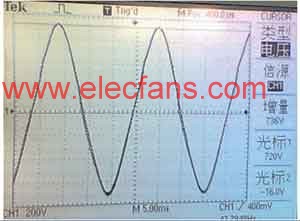System structure and control principle Boost + full-bridge inverter and output LC filter is one of the most commonly used topologies for high-power program-controlled AC power supplies. As shown in Figure 1, this is a two-stage non-isolated topology. The first stage is the boost stage, which is used to boost the module rectified voltage to the actual peak DC voltage (> 325V); the second stage is the inverter stage , It is used to convert the peak DC voltage into AC voltage, and then obtain 50Hz AC output voltage through the LC filter. The full-bridge inverter generally adopts the unipolar control mode, which is characterized by the two power tubes of the high-frequency arm that are complementarily switched at a higher switching frequency to ensure that an ideal sinusoidal output voltage waveform can be obtained; the other two power tubes are compared The fundamental frequency of the low output voltage works, which greatly reduces the switching losses. This full-bridge inverter is not one bridge arm is always low frequency (output fundamental frequency), the other bridge arm is always high frequency (carrier frequency), but it is switched to work with half the output voltage cycle, that is, the first half of the same bridge arm This cycle works at low frequency and in the second half of the week at high frequency, which ensures that the two bridge arm power tubes work in an equilibrium state, which improves the reliability of the system. Although this circuit has high efficiency, it needs to solve the isolation problem between input / output. Because the power of the program-controlled AC power supply of the cable tester is small, if the above scheme is adopted, it is large in size and complicated in control.

Figure 1 Boost + full-bridge inverter
If a monolithic integrated power amplifier device such as LM1875 is used, the maximum output power can reach 30W when powered by ± 30V. The connection method is similar to TDA2030, there are single and double power supply connection and BTL connection. The BTL connection method uses two LM1875, connected into a bridge circuit, the circuit structure and parameters on both sides are exactly the same, the integrated circuit on the right is controlled by the negative integrated circuit through a negative feedback resistor, and vice versa. It can obtain higher output power. As shown in Figure 2, the diode 1N4007 is used to prevent the output inductive load from generating overvoltage and damaging the device. The amplification factor of the circuit can be determined by the feedback resistance from the output to the inverting input. Class A, Class B, Class AB and other power amplifiers are all linear power amplifiers. The signal always stays in the amplification area. The output transistor acts as a linear regulator to adjust the output voltage. The result is reduced efficiency and limited output power.

Figure 2 BLM connection of LM1875
This design uses a class D audio amplifier to form a program-controlled AC power supply, and only need to control the input amplitude of the audio amplifier to obtain a high-purity sinusoidal AC voltage. Figure 3 shows the block diagram of the program-controlled AC power system developed, and the waveforms of each stage are given. The main circuit is composed of class D audio amplifier + half bridge and LC filter.

Figure 3 Basic configuration diagram of Class D audio amplifier
It is worth noting that half-bridge Class D audio amplifiers cause "bus voltage boost" because energy can flow in both directions, which causes the bus capacitors to be charged. In the half-bridge topology, the power supply faces energy returned from the power amplifier and causes severe bus voltage fluctuations or damage, especially when the power amplifier outputs low-frequency signals to the load. The difference between Class D amplifiers and synchronous buck converters is that the reference signal is a constantly changing audio signal, the duty cycle is constantly changing around 50%, the inductor current is bidirectional, and the two MOSFETs have the same effect.
The main loop design uses IRS2092 of International Rectifier (IR) Class D audio amplifier, which combines error amplifier, PWM comparator, gate drive stage circuit and overload protection function. Compared with IRS20955, it has great design flexibility. When powered by ± 100V, the maximum output power can reach 500W and the operating frequency can reach 800kHz. As shown in Figure 4, it includes a pulse width modulator, two output MOSFETs, and a low-pass filter to recover the amplified audio signal. Due to the output of 500V sine wave effective value, there is a low-frequency step-up transformer at the output. After comparing the audio input signal with the triangle wave generated by the internal oscillator, a PWM signal is obtained, and the duty cycle of the square wave is proportional to the input signal level. When there is no input signal, the duty cycle of the output waveform is 50%. Figure 5 shows the PWM output waveforms generated at different input signal levels.

Figure 4 Main circuit of program-controlled AC power supply
Using the BTL connection of the Class D audio amplifier IRS2092, a full bridge uses two half-bridge output stages and drives the load in a differential manner. The full-bridge structure works by switching the conduction path of the load, so the load current can flow in both directions without the need for a negative power supply or DC blocking capacitor. Under the same supply voltage, the theoretical maximum output power is 4 times that of the half-bridge amplifier. It can be popularized and applied to AC / AC conversion power supply with higher output power.
The key technology design program-controlled AC power supply requires 0 ~ 5V program-controlled DC level input corresponding to AC 0 ~ 500V (effective value) output. By changing the amplitude of the sine wave input of the class D audio amplifier, the corresponding output of the maximum 500V sine wave can be achieved. However, the problem of how to convert the 0 to 5V programmable DC level into the sine wave input of the class D audio amplifier needs to be solved first.
CD4051 is an 8-channel digital control analog switch, with three binary control input terminals A, B, C and INH input, which is equivalent to a single-pole eight-throw switch. Which channel the switch is turned on is determined by the input 3-bit address code C to decide. INH is the forbidden terminal. When INH = 1, all channels are not connected. In addition, the CD4051 also has a power supply terminal VEE, which is used as a level shifter, so that the digital signal provided by the CMOS circuit can directly control this multiplexer under the condition of a single power supply, and make this multiplexer It can transmit AC signals with peak-to-peak value up to 15V. For example, if the power supply of the analog switch is VDD = + 5V and VSS = 0V, when VEE = -5V, as long as a digital control signal of 0-5V is applied to the analog switch, the amplitude range can be controlled from -5V to + 5V Analog signal.

Figure 5 PWM output waveform
When designing, we must first consider how to generate a fixed amplitude sine wave reference signal as the analog input of CD4051. There are various schemes for generating a sine wave reference signal. A good sine waveform can be obtained from a Venturi oscillator, or a square wave output from a comparator can be used to obtain a triangular wave through an integrator, and then a differential amplifier or a low-pass filter can be used. To realize the transformation from triangle wave to sine wave.
The second is the high-precision sine wave reference signal program control. The simplest method is to use a microprocessor to perform 12-channel A / D conversion, and use these 12 channels to control the input terminals A, B, and C of CD4051 (INH = 0) , That is, 212 = 4096 states. As shown in Figure 6, switches D1 to D3 control the analog low bit, and D4 controls the high bit. Through reasonable calculation of R1a ~ R9d, 0 ~ 4096 states correspond to 0 ~ 5V programmable DC level input. It should be noted that the condition generated by the 4096th state is that when the 12 channels are all 0 and the INH = 1 of the fourth CD4051, it outputs the maximum value of the sine wave analog.

Figure 6 Program chart of sine wave reference signal

Figure 7 Sinusoidal voltage output waveform
Experimental results Using the above main circuit structure and control method, a prototype of a programmable power supply with 0 to 5V DC level input corresponding to 0 to 500V (effective value) AC output was developed. The fixed frequency is 50Hz, the output current is 5mA, the linearity is ≤1%, and the response Time ≤50ms, output overcurrent protection. The output waveform of the 5V program-controlled sinusoidal voltage is shown in Figure 7, which satisfies the requirements of the program-controlled power supply of the cable tester.
In Ceiling Speakers,Silk Diaphragm Tweeter,In Wall Ceiling Speakers,Two Way In Ceiling Speakers
The ASI Audio Technology Co., Ltd , https://www.asi-sound.com
